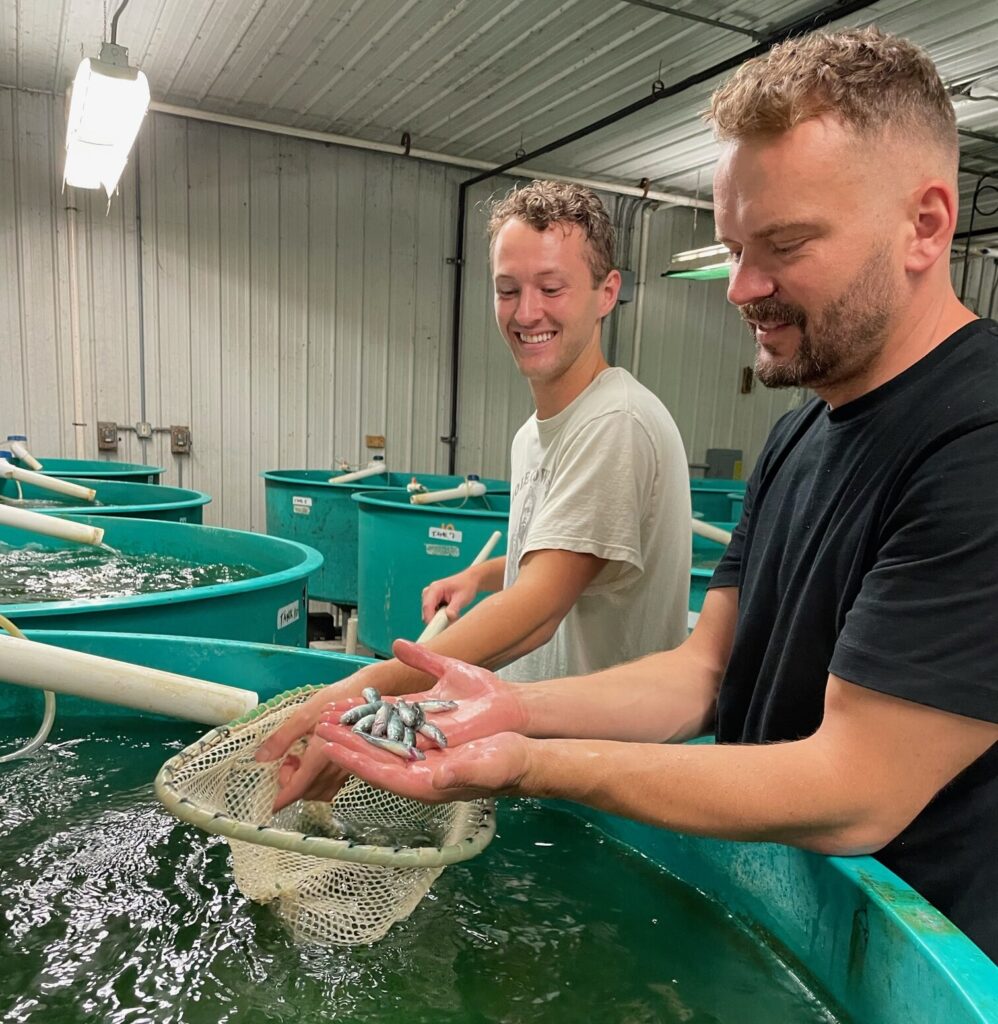
Features
Fish Health
Fish Nutrition
Research
Invasive species a new feed for yellow perch larvae
Researchers at Southern Illinois University Carbondale are making use of an invasive species by turning it into larvae feed.
February 16, 2023 By Bonnie Waycott
 Graduate student Peter Boessen and Dr. Michal Wojno co-Pi on the project (Photo: Karolina Kwasek)
Graduate student Peter Boessen and Dr. Michal Wojno co-Pi on the project (Photo: Karolina Kwasek) Assistant Professor Dr. Karolina Kwasek works with yellow perch, one of the most difficult freshwater fish to raise in captivity. But things could become less complicated thanks to her latest research. Kwasek and her team believe that a new feed made from the invasive species Asian carp would greatly increase the survival rate of yellow perch in hatcheries and lead to the development of more high-quality starter feeds.
The successful growth, health and survival of many fish, particularly in their early development, strongly depend on culture conditions, including food availability and water quality, making production in outdoor systems such as ponds often unpredictable, says Kwasek. To intensify production, aquaculture has been moving towards sustainable farming solutions indoors. However, this poses a challenge related to the lack of naturally-occurring live food that larval fish prey on. Consequently, the substitution of live food with formulated diets for the early life stages of fish has been a major focus in aquaculture to reduce costs and increase predictability of juvenile production.
Raising yellow perch indoors is also complicated, particularly at the larval stage, Kwasek explains. At hatching, the larvae are small in size with poor mobility and visibility. They are also highly cannibalistic and often unable to fill their swim bladders. However, much of the difficulty stems from successfully feeding them because the larvae are picky eaters with various limitations. So Kwasek and her team set out to find a suitable high-quality, digestible protein source, and came across Asian carp.
“Asian carp is a nutritionally balanced, highly digestible, widely available, sustainable and cost-effective protein source,” said Kwasek. “It has been previously shown to be a good replacement of marine fishmeal. We wanted to take a step further and evaluate it as a protein source in starter feeds. Now we are investigating how to incorporate it into larvae feed.”
Kwasek’s lab proposed the utilization of adult fish digestive tracts to digest protein sources for larval fish of the same species. The digestive tracts from adult perch were used to hydrolyse muscle of bighead carp to generate optimal protein hydrolysate that could be easily assimilated within the primitive digestive tract of larval perch. In other words, Kwasek and her team digested/hydrolysed carp muscle in vitro for the larvae using fully-developed digestive systems of the same species as the larvae.
“Asian carp muscle was homogenized first and mixed with digestive tracts from adult perch,” said Kwasek. “The mixture was then incubated in conditions which mimic perch optimal digestion and later freeze-dried. After the drying process, we mixed carp muscle hydrolysate powder with the remaining ingredients, processed the mix through cold-extrusion, spheronized it and freeze-dried it again. Finally, we sieved feed particles to obtain desired pellet sizes for feeding directly to the larvae.”
Results show high survival among the experimental groups (~50 per cent), 100 per cent swim-bladder inflation, and zero skeletal deformities. The experimental feeds were also characterized by high palatability and resulted in a high feed intake. Kwasek and her team have also proven a similar concept with largemouth bass. They hope to apply their method to marine species, and believe that their work has broad applications.
“Asian carp have threatened the Great Lakes via their irrepressible dispersion from previously established populations,” said Kwasek. “Harvest has been considered as one of the solutions to reduce their abundance, but because the species is not an acceptable food fish in the US, finding a market for them has been difficult. Our work shows a new opportunity to use Asian carp as a source of high quality protein in starter feeds for early fish stages. Our long-term goal is for the aquaculture to intensify, which in turn will require higher formulated feed input and hence, increased demand for cost-effective protein sources like carp.”
The work also addresses other big opportunities, including the utilization of invasive species and fish byproducts (guts) in the production of high-quality protein ingredients for larval feeds, and the production of more robust, healthy larval fish that can better adapt to formulated diets, making the weaning process (transition from live food to dry food) much easier.
“To support the sustainable growth of intensive aquaculture, the only feasible solution is to consider different byproducts generated along the food value chain as well as waste as resources,” said Kwasek. “We should shift our views from Asian carp being an “invasive species” to a high-value fish with a balanced nutritional profile that could be utilized in animal feeds or as human food.”
Together with University of Wisconsin Stevens Point (UWSP) Northern Aquaculture Demonstration Facility and Illinois-Indiana Sea Grant, Kwasek and her team will test similar sets of diets on walleye larvae in spring 2023. Their plan is also to include Asian carp in feeds for fingerlings (both perch and walleye) to determine its effect on the transition/weaning of those species from live food to dry pellet feed.
Print this page
Advertisement
- Zimbabwe receives $3.5M for tilapia farming
- Evaluation of a velocity assist inlet for improvement of hydrodynamics in dual-drain fish tanks





